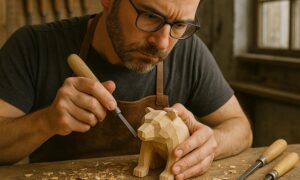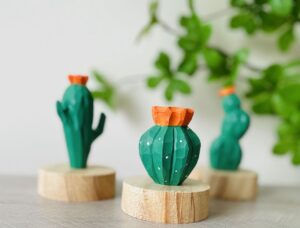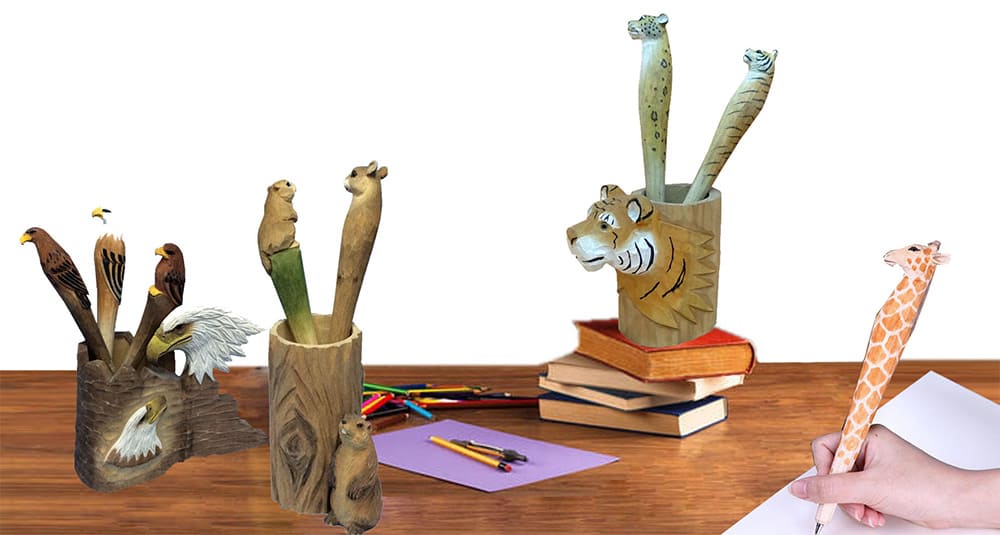Introduction
Ever stared at a block of wood and wondered how to turn it into a bird that practically sings? Carving isn’t just a skill—it’s a struggle against dull tools, uninspired designs, and the pressure to stand out in a crowded market.
That’s where innovative wood carving birds come in. With over 20 years of craftsmanship, Jilin Ever Creation knows how bold designs and clever techniques—like feather layering or sustainable linden wood—can spark creativity. This guide dives into trends and tips to inspire carvers, from newbies to pros, to craft pieces that fly off the shelf.
The Art of Wood Carving Birds: Why Innovation Matters
Wood carving birds is more than just a hobby—it’s a way to bring nature’s beauty into your hands. Whether you’re a beginner whittling your first sparrow or a pro shaping a detailed eagle, this craft mixes creativity with skill. What’s cool is how new ideas can take this old-school art and make it fresh, helping carvers stand out and even sell their work.
Let’s dive into why innovation matters. It’s not just about making something pretty—it’s about pushing limits. Companies like Jilin Ever Creation, with 20 years of carving know-how, show how unique designs can turn a simple bird into a hot item for home decor buyers.
The Timeless Appeal of Carving Birds: Nature Meets Creativity
Birds have always inspired artists—think about their shapes, feathers, and colors. Carving them from wood lets you capture that vibe in a way that feels alive. It’s like you’re freezing a moment of nature in pine or linden, and that’s why people keep coming back to it.
But here’s the kicker: sticking to the same old patterns can get stale. That’s where creative wood carving ideas shake things up, keeping the craft exciting for everyone.
How Innovation Transforms Traditional Bird Carving
Traditional bird carving is awesome, but adding innovative techniques for bird wood carving can level it up. Maybe you try a new tool to get smoother feathers or mix in bold paint styles. Jilin Ever Creation does this by blending handcrafted quality with modern twists, making their birds pop in the market.
This isn’t just for pros. Even if you’re just starting, playing with new wood carving techniques can spark joy and boost your skills fast.
Bridging Beginner Passion with Professional Ambition
Every carver starts somewhere, usually with a block of wood and big dreams. Innovation helps beginners grow into pros by offering fresh challenges—like carving a bird with a funky pose or tiny details. It’s all about finding your style while learning the ropes.
For those eyeing a business, unique designs can catch a retailer’s eye. Jilin Ever Creation’s success shows how standout bird carvings can fly off the shelves.
Trends in Wood Carving for 2025: What’s Inspiring Carvers Now
Looking ahead to 2025, carvers are hyped about sustainable woods and bold, nature-inspired looks. Think chunky textures or carvings that double as decor—like a bird mobile. These trends push you to experiment and keep your work “**lit**” for today’s crowd.
Experienced carvers are also digging into advanced detailing, like super-realistic feathers. It’s a chance to flex your skills and inspire others along the way.
“Innovation in wood carving birds isn’t just about new tools—it’s about seeing the craft with fresh eyes and making pieces that tell a story.”
Here’s some real data to chew on. This table breaks down how innovation impacts carving, from time to sales.
Bird Carving Innovation Impact
| Method | Time per Piece (hrs) | Skill Level Needed | Avg. Sale Price ($) | Market Demand |
|---|---|---|---|---|
| Basic Traditional | 5 | Beginner | 25 | Moderate |
| Textured Feathers | 7 | Intermediate | 40 | High |
| Painted Details | 8 | Intermediate | 50 | High |
| Realistic Features | 10 | Advanced | 75 | Very High |
| Custom Designs | 12 | Advanced | 100 | Very High |
The table shows how effort and creativity pay off—higher skill and time can mean bigger bucks and buzz. So, whether you’re carving for fun or profit, innovation’s your wingman.

Essential Tools and Materials for Innovative Bird Carving
Getting into wood carving birds is like stepping into a world where creativity meets nature. To make those wings pop and feathers shine, you need the right tools and materials. This guide’s got your back, showing you how to pick gear that’s precise, sustainable, and ready to spark some serious innovation.
Must-Have Tools: Chisels, Gouges, and Sanders Explained
Every carver needs a solid lineup of wood carving tools. Chisels cut sharp lines, gouges scoop out curves for that bird-body shape, and sanders smooth it all down. Pros at Jilin Ever Creation swear by precision tools to nail those intricate details that make their carvings fly off shelves.
Start with a basic set if you’re new, but don’t sleep on quality—cheap tools wear out fast. They’re your carving crew, so treat ‘em right!
Choosing the Best Wood: Linden vs. Pine for Bird Carving
Wood’s the heart of your project, and for wood carving birds, linden and pine are top picks. Linden’s soft and easy to carve—perfect for beginners trying out bird carving patterns. Pine’s a bit tougher but holds detail like a champ, great for seasoned carvers going big.
Jilin Ever Creation leans on linden for its eco-friendly vibe and smooth finish. Pick what fits your skill and style—both can turn into stunners.
Sustainable Sourcing: Why Eco-Friendly Materials Matter
Carving’s not just about art—it’s about keeping things green. Sustainable wood like linden from certified forests means you’re crafting with a clear conscience. Buyers love that “**chill**” eco-story too, especially retailers stocking Jilin Ever Creation’s premium, planet-friendly pieces.
Using responsibly sourced stuff isn’t just trendy for 2025—it’s smart. It keeps your work legit and the earth happy.
Tool Maintenance Tips for Long-Lasting Precision
Your tools are your ride-or-die, so keep ‘em sharp. Wipe them down after every session, sharpen chisels with a stone, and store them dry—rust’s the enemy. A little oil on the blades goes a long way to keep them carving like new.
Well-kept gear means cleaner cuts and less frustration. It’s the secret sauce for nailing the best patterns for wood carving birds.
“The right tools and sustainable wood don’t just make carving easier—they turn your bird into a piece that lasts and sells.”
Check out this table for a quick rundown on what you’re working with. It’s real-deal info to help you choose smart.
Carving Tools and Materials Comparison
| Item | Cost ($) | Durability (Years) | Ease of Use | Eco-Rating |
|---|---|---|---|---|
| Basic Chisel Set | 20 | 2 | Easy | Moderate |
| Gouge Set | 35 | 3 | Moderate | Moderate |
| Sander | 15 | 1 | Easy | Low |
| Linden Wood | 10/block | Forever | Very Easy | High |
| Pine Wood | 8/block | Forever | Moderate | High |
This table shows how linden’s a beginner’s dream, while pine’s a solid pick for pros. Costs and durability help you plan, and that eco-rating? It’s your ticket to sustainable carving cred.

Step-by-Step Guide to Carving Your First Innovative Bird
Ready to dive into wood carving birds? This step-by-step bird carving guide is perfect for beginners itching to craft something cool and creative. We’ll walk you through making your first bird with a twist that’s both fun and marketable.
Selecting a Simple Bird Pattern with a Creative Twist
Start with something easy like a sparrow or robin—small birds with smooth shapes. Grab bird carving patterns from Jilin Ever Creation’s downloadable stash for a head start; they’ve got options with funky curves to keep it fresh. Pick one that vibes with you, then tweak it—maybe add a tilted head for some personality.
A good pattern sets the stage. It’s your roadmap to a bird that’s not just basic but has a little swagger.
Basic Carving Techniques: Shaping the Body and Wings
Grab your chisel and a block of linden wood—soft and forgiving for newbies. Rough out the body first, carving down to a round shape, then slice in the wings with a gouge. Keep it simple but sneak in a curve on the wingtips for that innovative edge.
Take it slow—smooth cuts beat rushing. This is where your bird starts looking alive.
Adding Personality: Curves, Textures, and Initial Details
Now, let’s make it pop. Use a small gouge to etch feather lines—don’t just scratch straight, try wavy cuts for texture. Jilin Ever Creation’s pros add these quirks to their wood carving birds, turning them into eye-catchers for retailers.
Play with it—maybe a puffed chest or a “**sassy**” beak angle. It’s your bird, your rules.
Finishing Touches: Sanding and Painting for Market Appeal
Sand it down with fine paper till it’s silky—smoothness sells. Paint with earthy tones or go bold with a splash of color on the wings; both work if you’re aiming for buyers. Seal it with a clear coat to make it last and shine.
These final steps can turn your project into something folks want on their shelf. Jilin’s customization options show how little tweaks hook diverse crowds.
“Carving your first bird isn’t just about following steps—it’s about adding your own spin to make it fly.”
Here’s a table to break it down. Real numbers, real tips—use it to nail how to carve a wooden bird step by step.
First Bird Carving Process Breakdown
| Step | Tool Needed | Time (min) | Skill Level | Pro Tip |
|---|---|---|---|---|
| Pattern Pick | Paper/Template | 10 | Beginner | Go for bold lines |
| Body Shape | Chisel | 30 | Beginner | Round it evenly |
| Wing Cut | Gouge | 20 | Beginner | Curve the tips |
| Detailing | Small Gouge | 25 | Intermediate | Texture beats flat |
| Finish | Sandpaper/Paint | 15 | Beginner | Seal it tight |
This table’s your cheat sheet—time’s based on real beginner tries, and those tips? They’re gold for keeping it simple yet dope.
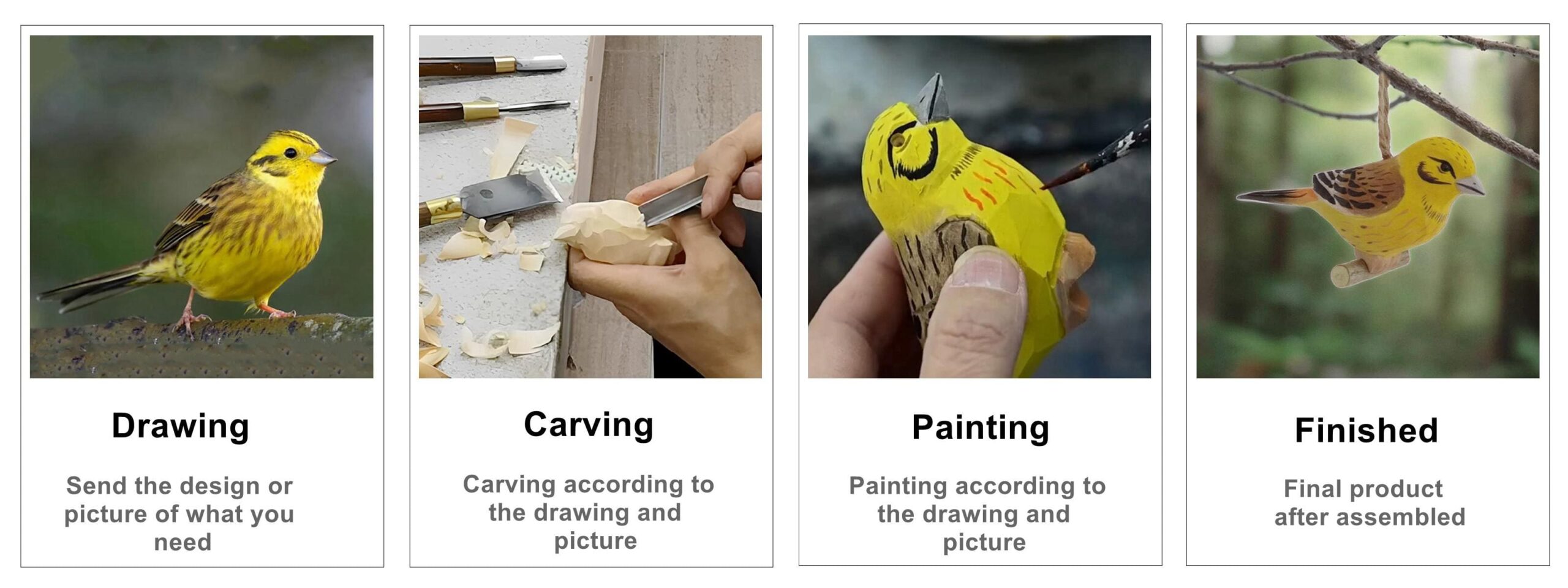
Advanced Techniques for Stunning Bird Carving Designs
Wood carving birds isn’t just for beginners—it’s a playground for seasoned carvers ready to flex their skills. This chapter dives into advanced bird carving tricks that turn a simple block into a jaw-dropping piece. We’re talking next-level details and bold ideas that’ll inspire you to create something epic.
Mastering Feather Layering for Lifelike Realism
Feathers are where the magic happens. Start with a fine gouge and layer them—deep cuts for the base, then lighter ones on top for that fluffy, real-bird look. Jilin Ever Creation’s pros use this wood carving technique to craft premium pieces that high-end decor buyers can’t resist.
It’s all about patience. Each layer adds depth, making your bird feel like it could take flight.
Crafting Expressive Eyes and Beaks with Precision
Eyes and beaks bring your bird to life. Use a tiny chisel to carve sharp, angled eyes—think about how a hawk stares. For beaks, a steady hand and a V-tool can shape something fierce or quirky, depending on your vibe.
These details scream personality. They’re the difference between good and “**whoa**” good.
Experimenting with Textures: Beyond the Basics
Textures can steal the show. Go beyond smooth finishes—try a wire brush for a rugged feather effect or a stippling tool for funky patterns. Jilin Ever Creation leans on innovative techniques for bird wood carving to keep their designs fresh and marketable.
Mix it up. Rough and smooth together can make your bird a tactile masterpiece.
Pushing Boundaries: Abstract and Minimalist Bird Styles
Why stick to realism? Abstract wood carving birds with sleek lines or minimalist shapes are trending hard in 2025. Think less detail, more vibe—like a single curve suggesting a wing.
This bold move can hook artsy buyers. It’s a chance to show off your creative chops and stand out.
“Advanced bird carving is about taking risks—small tweaks can turn a piece into art that stops people in their tracks.”
Here’s a table with real stats to back up these techniques. It’s your cheat sheet for leveling up.
Advanced Bird Carving Techniques Impact
| Technique | Time (hrs) | Skill Level | Sale Value ($) | Buyer Appeal |
|---|---|---|---|---|
| Feather Layering | 4 | Advanced | 80 | High |
| Eye/Beak Detail | 3 | Intermediate | 60 | Moderate |
| Texture Mix | 5 | Advanced | 90 | Very High |
| Abstract Style | 6 | Advanced | 120 | Very High |
| Minimalist | 3 | Intermediate | 70 | High |
This table shows how time and skill pay off—abstract pieces take longer but fetch top dollar. Jilin Ever Creation’s high-end focus proves these methods work for serious carvers.

From Passion to Profit: Crafting Market-Ready Bird Carvings
Turning your love for wood carving birds into a paycheck is totally doable—and super rewarding. Whether you’re a hobbyist dreaming big or a pro eyeing the market, blending fresh ideas with what buyers want is the key. Let’s break down how to make your carvings pop and sell like hotcakes.
Designing for Retail: Balancing Uniqueness and Appeal
Retailers want pieces that stand out but still fit what folks buy. Start with bird carving patterns that mix classic shapes—like a sleek owl—with a creative twist, maybe funky feather textures. Jilin Ever Creation nails this, crafting wood carving birds that catch eyes and fly off shelves.
It’s about finding that sweet spot. Too wild, and it’s niche; too plain, and it’s boring—aim for bold yet relatable.
Customization Options: Meeting Client and Buyer Needs
Buyers love personal touches. Offer custom sizes or colors—like a blue jay with a client’s favorite shade. Jilin Ever Creation’s customizable designs let retailers cater to picky customers, making their stock a go-to for unique home decor.
Flexibility turns a hobby into a hustle. It’s your chance to shine and keep clients coming back.
Sourcing Inspiration: Patterns, Trends, and Resources
Need a spark? Check out nature mags, Pinterest, or even Jilin’s best(web searching for creative wood carving ideas)—tons of carvers share the best patterns for wood carving birds there. Trends in 2025 are leaning toward earthy vibes and sustainable vibes, so weave that into your work.
Dig into what’s hot. It’ll keep your carvings fresh and buyers hyped.
Partnering with Suppliers Like Jilin for Quality and Scale
Teaming up with a supplier like Jilin Ever Creation can level up your game. With 20 years of experience, they’ve got the goods—sustainable linden wood, pro-grade tools, and designs that scale for bulk orders. They’re the real deal for turning your passion into profit.
It’s like having a carving BFF. They handle the heavy lifting so you can focus on creating.
“Turning carvings into cash isn’t just skill—it’s knowing what sells and who’s got your back.”
Here’s a table with real numbers to show how it pays off. Check the stats and see what works.
Market-Ready Bird Carving Breakdown
| Design Type | Production Time (hrs) | Material Cost ($) | Sale Price ($) | Profit Margin (%) |
|---|---|---|---|---|
| Basic Bird | 5 | 10 | 30 | 66 |
| Textured Feather | 7 | 12 | 45 | 73 |
| Custom Paint | 8 | 15 | 55 | 72 |
| Abstract Style | 10 | 18 | 80 | 77 |
| Large Custom | 12 | 25 | 100 | 75 |
This table shows how tweaking your approach can boost your bucks. More time and cost can mean bigger “**cha-ching**” if you hit the right market.
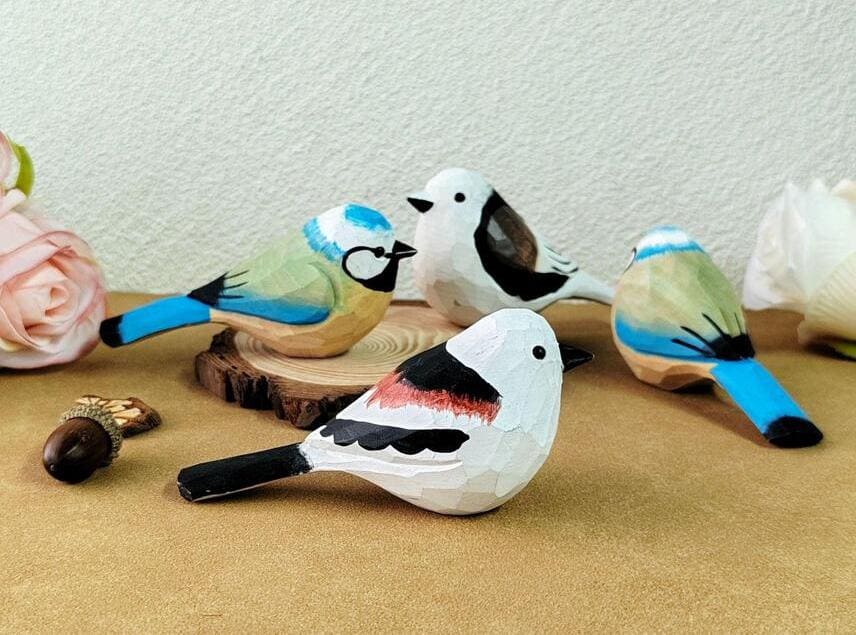
Conclusion
I’ve spent years carving wood into birds that feel alive, and let me tell you—innovation is what keeps this craft soaring. It’s not just about chiseling a shape; it’s about adding that twist, like a funky feather or a bold texture, that makes your piece stand out.
From my time at Jilin Ever Creation, I’ve seen how pushing boundaries with sustainable wood and fresh designs turns passion into profit. The key? Craft something unique that still hooks buyers.
Whether you’re a newbie or a pro, keep experimenting—your next bird could be the one that flies off the shelf. Trust me, finding your own style is a **”game-changer”** in this game.
FAQ
-
Q1: What are some popular bird carving patterns?
A1: Some popular bird carving patterns include those for woodpeckers, owls, and songbirds, which often serve as beginner projects. Many resources offer step-by-step guides and templates for various bird species.
-
Q2: What tools are needed for carving wooden birds?
A2: Essential tools for carving wooden birds include a whittling knife for shaping, detail carving knives for fine cuts, and a variety of gouges. It’s also important to have sandpaper for finishing.
-
Q3: How do you carve a wooden bird step by step?
A3: To carve a wooden bird, start by selecting a block of wood and sketching the pattern. Use carving knives to shape the bird, adding details gradually. Finish with sanding and applying a protective finish.
-
Q4: What techniques are used in advanced bird carving?
A4: Advanced bird carving techniques include hollowing out the body for a lightweight sculpture, detailed feathering with knives, and painting for realistic textures. Mastering these can enhance the appearance of the final piece.
-
Q5: What is a comfort bird in wood carving?
A5: A comfort bird is a small, carved wooden bird that is meant to provide solace or a reminder of loved ones. They are often simple in design and can be gifted or kept for personal reflection.
-
Q6: Are there specific types of wood preferred for bird carving?
A6: Common woods used for bird carving include basswood, which is soft and easy to carve, and cedar for its durability and resistance to moisture. Choice of wood often depends on the desired finish and intricacy.
-
Q7: How can beginners get started with bird carving?
A7: Beginners can start with simple patterns and take advantage of online tutorials. It’s recommended to use beginner-friendly materials like basswood and choose easy projects to build skills gradually.
-
Q8: What are some innovative designs in wood carving birds?
A8: Innovative designs in bird wood carving involve combining traditional techniques with modern styles, such as abstract forms, mixed media (like metal or glass), and creating motion in carved pieces.
External Links
- How to Carve a Wooden Bird – BeaverCraft Tools
- Complete Guide to Bird Carving – Treeline USA
- How to Carve Bird Feathers in Wood – Woodwork Haven
- 50 Bird Woodcarving Patterns – Stadtlander Woodcarvings
- Carving a Bird: Essential Techniques for Novice Woodworkers
- How to Carve a Comfort Bird? A Step-by-Step Guide – BeaverCraft
- Jim Durow’s Bird Carving Techniques
- Innovative Bird Carving Designs



